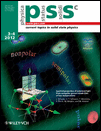Characterization of InGaN/GaN epitaxial layers by aberration corrected TEM/STEM
Abstract
In this study, the thickness, interface quality, and elemental composition of InGaN/GaN epitaxial layers are investigated. Samples were grown by Metal-Organic Chemical Vapour Deposition (MOCVD) on sapphire (0001) substrates. The structure was designed to form In0.1Ga0.9N quantum wells (QWs) with thicknesses decreasing from 8 nm to 0.25 nm embedded between 10 nm GaN barriers. Scanning transmission electron microscopy (S)TEM, energy-dispersive X-ray spectroscopy (EDXS) and electron energy loss spectroscopy (EELS) have been applied using both a JEOL 2010F field-emission gun (FEG) TEM/STEM microscope and the newly developed spherical aberration-corrected JEOL R005 cold FEG (S)TEM. The peak indium concentration of the widest QWs was determined to lie between 0.12 and 0.15 (© 2012 WILEY-VCH Verlag GmbH & Co. KGaA, Weinheim)




